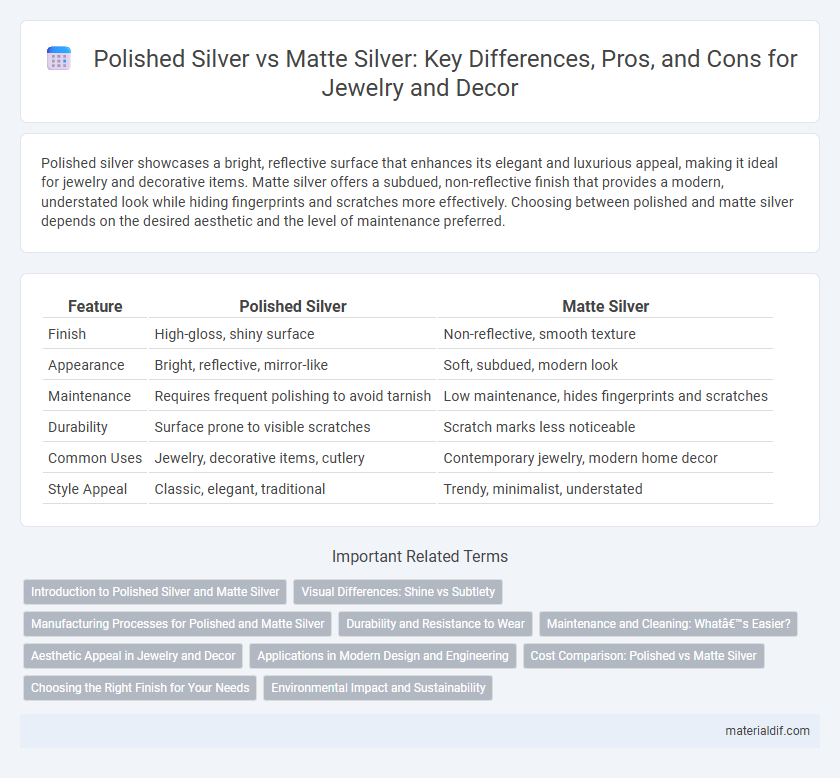Polished silver showcases a bright, reflective surface that enhances its elegant and luxurious appeal, making it ideal for jewelry and decorative items. Matte silver offers a subdued, non-reflective finish that provides a modern, understated look while hiding fingerprints and scratches more effectively. Choosing between polished and matte silver depends on the desired aesthetic and the level of maintenance preferred.
Table of Comparison
| Feature | Polished Silver | Matte Silver |
|---|---|---|
| Finish | High-gloss, shiny surface | Non-reflective, smooth texture |
| Appearance | Bright, reflective, mirror-like | Soft, subdued, modern look |
| Maintenance | Requires frequent polishing to avoid tarnish | Low maintenance, hides fingerprints and scratches |
| Durability | Surface prone to visible scratches | Scratch marks less noticeable |
| Common Uses | Jewelry, decorative items, cutlery | Contemporary jewelry, modern home decor |
| Style Appeal | Classic, elegant, traditional | Trendy, minimalist, understated |
Introduction to Polished Silver and Matte Silver
Polished silver features a smooth, highly reflective surface that enhances its brightness and mirror-like shine, making it popular for jewelry and decorative items. Matte silver has a textured, non-reflective finish that offers a subtle, understated elegance and resists showing fingerprints or scratches. Both finishes provide distinct aesthetic qualities, catering to different style preferences and functional needs in silver products.
Visual Differences: Shine vs Subtlety
Polished silver features a highly reflective, mirror-like finish that enhances brightness and highlights intricate details, creating a striking, shiny appearance. Matte silver, in contrast, exhibits a soft, non-reflective surface that emphasizes subtlety and texture, offering a more understated and modern aesthetic. The choice between polished and matte silver significantly impacts the visual appeal, with polished silver catching light vividly while matte silver provides a muted, elegant look.
Manufacturing Processes for Polished and Matte Silver
Polished silver is created through a detailed process involving multiple stages of buffing and polishing using fine abrasives and polishing compounds to achieve a reflective, mirror-like finish. Matte silver, on the other hand, results from a manufacturing process that employs techniques such as sandblasting, chemical etching, or brushing to produce a non-reflective, textured surface. These distinct finishing processes impact not only the visual appearance but also the tactile feel and maintenance requirements of silver products.
Durability and Resistance to Wear
Polished silver features a smooth, reflective surface that can show scratches and tarnish more readily, requiring regular maintenance to preserve its shine. Matte silver has a textured, non-reflective finish that better conceals minor scuffs and fingerprints, offering enhanced resistance to visible wear over time. Both finishes are composed of the same silver alloy, but matte silver is generally preferred for durability in everyday use due to its ability to mask surface imperfections.
Maintenance and Cleaning: What’s Easier?
Polished silver requires frequent cleaning and polishing to maintain its shiny, reflective surface, as it is prone to tarnishing and fingerprints. Matte silver, with its non-reflective finish, hides smudges and minor scratches better, reducing the need for constant maintenance. Regular use of a soft cloth and mild cleaning solutions is sufficient for matte silver, making it easier to care for compared to polished silver.
Aesthetic Appeal in Jewelry and Decor
Polished silver offers a reflective, mirror-like finish that enhances the brilliance and luxury of jewelry and decorative pieces, making them stand out with a shiny, eye-catching appeal. Matte silver, characterized by its subtle, non-reflective surface, provides a modern, understated elegance favored in minimalist and contemporary designs. The choice between polished and matte silver significantly influences the aesthetic appeal, with polished silver highlighting intricate details and matte silver delivering a muted, sophisticated look.
Applications in Modern Design and Engineering
Polished silver, with its reflective and smooth surface, is favored in luxury design applications such as jewelry, high-end electronics, and decorative elements where visual appeal and brightness are crucial. Matte silver, characterized by its non-reflective, brushed texture, finds extensive use in modern architectural accents, automotive parts, and industrial design due to its understated elegance and resistance to glare. Both finishes leverage silver's excellent conductivity and corrosion resistance, making them suitable for diverse engineering applications from circuitry to precision instruments.
Cost Comparison: Polished vs Matte Silver
Polished silver typically incurs higher costs due to the extra labor and finishing processes required to achieve its reflective, shiny surface. Matte silver, with its less complex, brushed or satin finish, generally demands less intensive polishing, resulting in lower production expenses and a more affordable price point. Consumer preferences for durability and maintenance may also influence the overall value perception between polished and matte silver options.
Choosing the Right Finish for Your Needs
Polished silver offers a shiny, reflective surface that enhances elegance and highlights intricate details, making it ideal for formal occasions and decorative items. Matte silver features a non-reflective, subdued finish that resists fingerprints and scratches, suited for everyday wear and modern aesthetics. Selecting between polished and matte silver depends on the desired durability, maintenance level, and style preference to match your specific needs.
Environmental Impact and Sustainability
Polished silver requires frequent cleaning with chemical polishes that may contain harmful substances, leading to higher environmental pollution compared to matte silver, which maintains its appearance with minimal maintenance. Matte silver's reduced need for harsh cleaning agents contributes to lower water contamination and decreased chemical waste. Choosing matte silver supports sustainable practices by minimizing toxic chemical use and promoting longer-lasting, eco-friendly silver products.
Polished Silver vs Matte Silver Infographic

 materialdif.com
materialdif.com